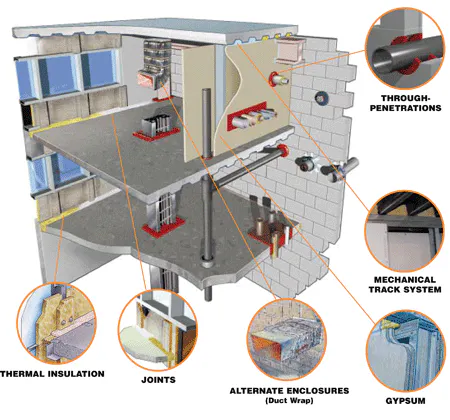Many facility owners frequently ask me, as a fire protection engineer, what services I provide. Typical anticipated answer to elaborate or something along the lines of: "Oh right. Sprinkler systems.
Fire protection doesn't end with the suppression side of engineering, despite its widespread recognition for its effectiveness in putting out or suppressing fires.
There are several types of protection against fire, including both passive and active components. Automatic sprinklers, clean agent suppression systems, hose reels for manual suppression, fire alarms, and smoke management systems are examples of active fire defence.
On the other hand, passive fire protection refers to building components that are designed to either contain a fire or offer structural parts fire-retardant protection against excessive heat that could otherwise lead to their failure. Most people tend to undervalue and ignore passive fire prevention.
Compared to active fire defence, passive fire protection lacks the action! The majority of people are unaware of how wise it is to construct a 3- or 4-hour wall to safeguard lives and property without ever having seen a fire wall. It's not safe to assume that, even if they traversed a dead end distance ten times a day, 99.99% of people would not know what it was.
Passive fire protection features are key pillars of fire protection that most people have little to no understanding of. Some of these include:
-
Fire-resistance-rated walls, floors, and ceiling/roofs
-
Fire-resistance-rated structural members
-
Fire-protection-rated doors and windows
-
Penetration fire stop sealants systems
-
Fire dampers, smoke dampers,
-
Smoke barrier construction.
Passive fire containment is intended to;
-
Protects occupants during emergencies
-
Protects the spread of fire and smoke via vertical shaft opening
-
Separates hazards
-
Protects building systems and construction

Combining active, passive protection
Combining active and passive fire safety components to create a more comprehensive system is very common. To stop smoke from building up in the escape stairs, high-rise exit enclosures might be positively pressurised or ventilated. In addition to providing a passive barrier to prevent smoke from migrating into the stair in addition to the active smoke management fans, the passive, two-hour fire-resistive and smoke-tight construction also acts as a passive barrier to positively pressurise the stairs.
Passive smoke barriers are used in the majority of smoke management zone separations to divide and compartmentalise smoke areas. Similarly, to provide a more comprehensive system, Hotel rooms in buildings may use both active and passive fire protection. To create the barrier required to contain the smoke, large atriums may feature smoke barrier protection in addition to walls with a 2-hour fire resistant rating. Through-penetration firestop systems are used to block wall penetrations, and smoke dampers are installed in ductwork to stop smoke from escaping through ducted vents and the air conditioning system.
We need both active and passive fire protection measures to offer the level of protection that building requires because neither is 100% effective.
Finding a balance
Whether you support passive or active fire safety features, or you are only a spectator, each has advantages and fulfils a purpose. It is impossible to dispute the degree of protection provided by both active and passive fire safety systems. While upkeep and dependability will always be concerns, it is crucial to strike the correct mix between active and passive security for your particular project.
As has been shown time and time again, the best fire protection design may call for a combination of active and passive fire safety elements. A few instances of balancing active and passive fire safety features are exit enclosures with stair pressurisation systems, data centres with walls rated for fire resistance, and clean agent suppression systems.
Minimum standards for both passive and active fire protection are provided by National building codes; it is crucial for designers to comprehend and implement these criteria in order to ensure compliance. It's feasible that both active and passive fire safety features are used to achieve this equilibrium.
Remember that the two types of protection serve distinct purposes when deciding which is best. Both passive and active fire defence are essential for preventing fires. The fire will be put out by active fire protection, and its spread will be stopped by passive fire protection. Together, they limit collateral damage to equipment that may be essential to sustaining the operation of vital infrastructures and enable building occupants to leave the facility safely.
Given the increase in fire incidents and fatalities, India need education and training on passive fire safety. Many users are not aware the technical difference of fire doors and wooden doors , which can truly save their lives in the event of a fire. Usage of fire and smoke protected building materials which are certified and listed for their intended use, they can help avoid fires. When the architectural community and design experts work together to develop and build fire-safe designs, we can overcome obstacles and create a fire-safe India.

Hemant Khadse
Hemant Khadse is CEO of East Corp Group, fire and life safety consultant. He is engineering graduate with work experience of 30 years in fire and security; He has travelled and worked internationally. He is also certified fire safety trainer and conducted many FLS audits and risk assessments for many Hotels in India and globally.